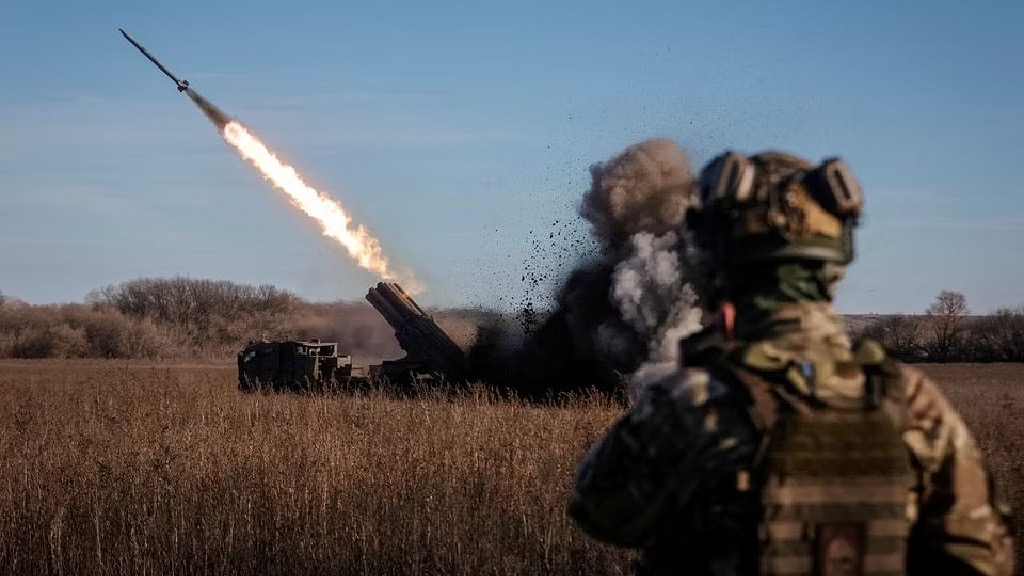01:27

On January 17, 1961, U.S. President Dwight D. Eisenhower sat down before television cameras to give a farewell address famous for one clear message – beware the military-industrial complex.
The combination of a large military establishment and a thriving arms industry is a new phenomenon in American history, he said, but the U.S. must understand its "grave implications," as the country's "toil, resources and livelihood are all involved."
Sixty years have passed, and the military-industrial complex continues to thrive and expand further into U.S. political life.
The U.S. grew into world's largest industrial power from the end of the 19th century to the end of the First World War. It expanded overseas interests by developing its military power, which laid the foundation for the growth of its military-industrial complex.
With the outbreak of the Second World War, President Franklin D. Roosevelt established the War Production Board to coordinate civilian industries for wartime production. Prior to this, the government owned its own shipyards and weapons manufacturing facilities.
The military-industrial complex grew further as a result of the mass production of aircraft during the Cold War, which also benefited the civilian aircraft industry.

A draft of President Dwight D. Eisenhower's farewell address shows changes made around a reference to the military industrial complex at the Eisenhower Presidential Library in Abilene, Kansas, the U.S., December 10, 2010. /AP
A draft of President Dwight D. Eisenhower's farewell address shows changes made around a reference to the military industrial complex at the Eisenhower Presidential Library in Abilene, Kansas, the U.S., December 10, 2010. /AP
A powerful lobby
Throughout U.S. history, presidents, lawmakers and officials have been susceptible to lobbying and influence efforts from various sources, including the Department of Defense and the Bureau of Political-Military Affairs, legislators representing districts where defense manufacturing plants are located and representatives of private firms involved in weapons production.
These entities maintain close connections. Legislators who receive campaign contributions from military firms may be inclined to vote in favor of funding projects involving those companies. Likewise, military firms often employ former Defense Department officials as lobbyists, further solidifying these mutually beneficial relationships.
From 2002 to 2020, military contractors tripled their political donations to congressional candidates, according to OpenSecrets, a non-profit organization that tracks data on campaign finance and lobbying. This is what Eisenhower warned about – if the influence of the military-industrial complex was left uncheck, it could threaten democracy itself.
"American-style democracy advocates that everyone has one vote, but ordinary voters simply cannot compete with the campaign investment paid by the big financial groups in the military-industrial complex," said Zhang Tengjun, deputy director of the China Institute of International Studies Asia Pacific.
Another powerful tool of the military-industrial complex is its ability to shape elite discussions on national security issues by funding foreign policy think tanks.
At least 14 of the 15 think tanks represented in House Armed Services Committee hearings from January 2020 to September 2022 accepted arms industry cash, according to "US government and defense contractor funding of America's top 50 think tanks" report by Bee Freeman, a research fellow with expertise in lobbying and money in politics at the Quincy Institute for Responsible Statecraft.
"Think tanks are supposed to shape government policies in an unbiased manner, free from the influence of big money that can distort in-house policy planning," said Stephen Semler, cofounder of Security Policy Reform Institute, a grassroots-funded U.S. foreign policy think tank.
However, many of the most influential think tanks have been compromised by the same financial interests as Congress, including military contractors, Semler argued.

A man walks past an apartment building heavily damaged in the Russia-Ukraine conflict, in Mariupol, Ukraine, November 16, 2022. /Reuters
A man walks past an apartment building heavily damaged in the Russia-Ukraine conflict, in Mariupol, Ukraine, November 16, 2022. /Reuters
Driving force behind wars
From 1991 to 2022, the U.S. launched at least 251 military interventions, according to the Congressional Research Service, a U.S. think tank that compiles information on behalf of Congress.
Companies in the weapons industry depend on government contracts and flourish during prolonged military engagements. The more conflicts the U.S. is involved in, the greater the demand for weapons, ammunition and military equipment, resulting in substantial financial profits for these companies.
Since the Ukraine conflict began, the U.S. and its European allies have sent heavy weapons, including the advanced missile launcher Himars, to Kyiv. During the G7 summit, President Joe Biden expressed Washington's support for collaborative training programs for Ukrainian pilots on F-16 fighter jets.
Weapons contractors are the main financial beneficiary. One-quarter to one-third of all Pentagon contracts in recent years have gone to just five major weapons contractors, including Lockheed Martin and Boeing, according to research from the Watson Institute at Brown University.
The direct military sales by U.S. companies rose nearly 50 percent in fiscal year 2022 from the previous year, data released by the U.S. State Department shows.
Since 2000, the military-industrial complex has led the U.S. into disastrous wars of choice in Afghanistan, Iraq, Syria, Libya, and now Ukraine, according to Jeffrey D. Sachs, a professor of the Center for Sustainable Development at Columbia University.

Ukrainian servicemen use a Bureviy multiple launch rocket system at a position in Donetsk region, Ukraine, November 29, 2022. /Reuters
Ukrainian servicemen use a Bureviy multiple launch rocket system at a position in Donetsk region, Ukraine, November 29, 2022. /Reuters
The cost for America
The U.S. routinely spends far more on its military than any other country. In 2022, it accounted for more than one third of world military spending, with a total annual spend larger than the next 10 countries combined, according to the Stockholm International Peace Research Institute.
Over the years, U.S. military spending has continuously hit record highs. In 2000, government debt was $3.5 trillion, accounting for 35 percent of GDP. However, according to Sachs, by 2022 the debt had surged to $24 trillion, representing a staggering 95 percent of GDP.
The ongoing wars have been predominantly funded through borrowing, resulting in a widening of the U.S. budget deficit and a surge in the national debt. Failure to promptly repay the borrowed funds allocated to war will also lead to large future interest payments. According to researchers from Brown University, by the 2050s, these interest payments could total over $6.5 trillion.
Researchers said that although military spending does produce jobs, investment in non-military public infrastructure like roads, hospitals and schools has not grown at the same rate as investment in military infrastructure.
This was another of Eisenhower's concerns – the military-industrial complex could promote policies that may not serve the best interests of the country, like diverting valuable resources away from education and healthcare.